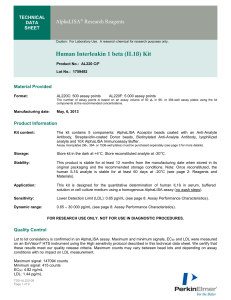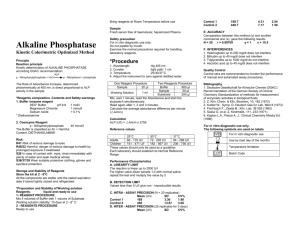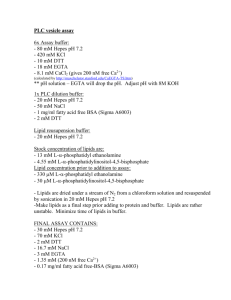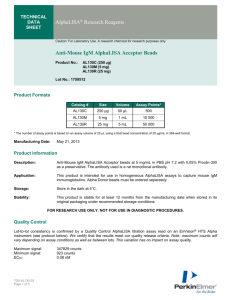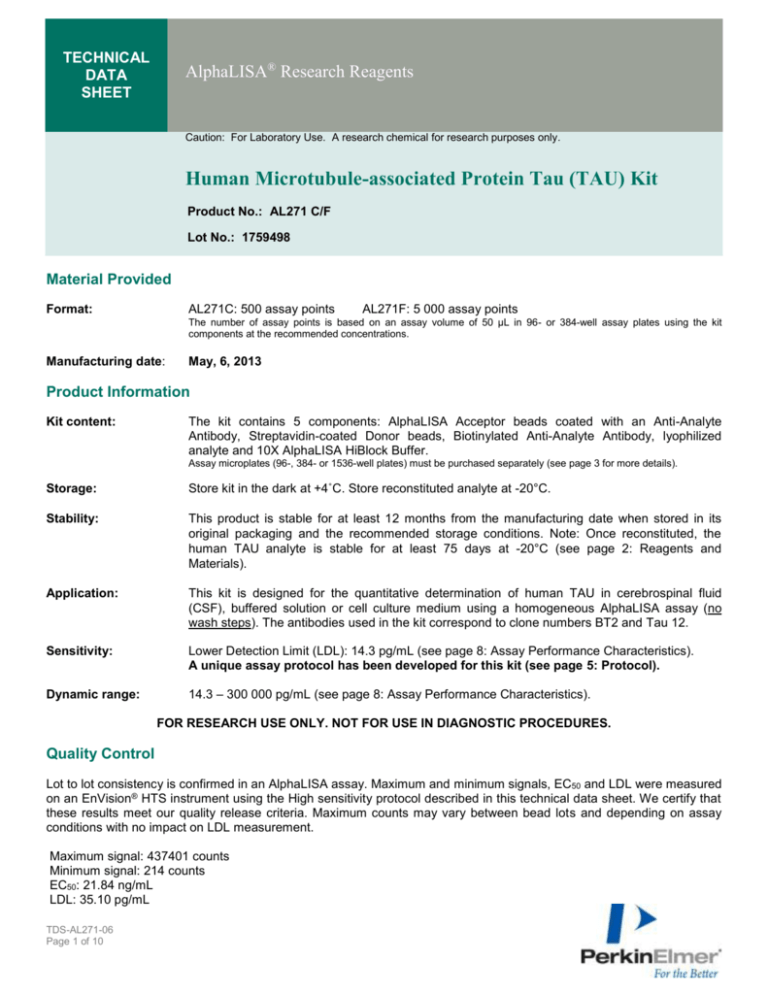
TECHNICAL
DATA
SHEET
AlphaLISA® Research Reagents
Caution: For Laboratory Use. A research chemical for research purposes only.
Human Microtubule-associated Protein Tau (TAU) Kit
Product No.: AL271 C/F
Lot No.: 1759498
Material Provided
Format:
AL271C: 500 assay points
AL271F: 5 000 assay points
The number of assay points is based on an assay volume of 50 µL in 96- or 384-well assay plates using the kit
components at the recommended concentrations.
Manufacturing date:
May, 6, 2013
Product Information
Kit content:
The kit contains 5 components: AlphaLISA Acceptor beads coated with an Anti-Analyte
Antibody, Streptavidin-coated Donor beads, Biotinylated Anti-Analyte Antibody, lyophilized
analyte and 10X AlphaLISA HiBlock Buffer.
Assay microplates (96-, 384- or 1536-well plates) must be purchased separately (see page 3 for more details).
Storage:
Store kit in the dark at +4˚C. Store reconstituted analyte at -20°C.
Stability:
This product is stable for at least 12 months from the manufacturing date when stored in its
original packaging and the recommended storage conditions. Note: Once reconstituted, the
human TAU analyte is stable for at least 75 days at -20°C (see page 2: Reagents and
Materials).
Application:
This kit is designed for the quantitative determination of human TAU in cerebrospinal fluid
(CSF), buffered solution or cell culture medium using a homogeneous AlphaLISA assay (no
wash steps). The antibodies used in the kit correspond to clone numbers BT2 and Tau 12.
Sensitivity:
Lower Detection Limit (LDL): 14.3 pg/mL (see page 8: Assay Performance Characteristics).
A unique assay protocol has been developed for this kit (see page 5: Protocol).
Dynamic range:
14.3 – 300 000 pg/mL (see page 8: Assay Performance Characteristics).
FOR RESEARCH USE ONLY. NOT FOR USE IN DIAGNOSTIC PROCEDURES.
Quality Control
Lot to lot consistency is confirmed in an AlphaLISA assay. Maximum and minimum signals, EC50 and LDL were measured
on an EnVision® HTS instrument using the High sensitivity protocol described in this technical data sheet. We certify that
these results meet our quality release criteria. Maximum counts may vary between bead lots and depending on assay
conditions with no impact on LDL measurement.
Maximum signal: 437401 counts
Minimum signal: 214 counts
EC50: 21.84 ng/mL
LDL: 35.10 pg/mL
TDS-AL271-06
Page 1 of 10
Precautions
Only the AlphaScreen® Donor beads are light-sensitive. All the other assay reagents can be used under normal light
conditions. All Alpha assays using the Donor beads should be performed under subdued laboratory lighting
(< 100 lux). Green filters (LEE 090 filters (preferred) or Roscolux filters #389 from Rosco) can be applied to light
fixtures.
All blood components and biological materials should be handled as potentially hazardous. Some analytes are from
human source.
Some analytes are present in saliva. Take precautionary measures to avoid contamination of the reagent solutions.
The Biotinylated Anti-Analyte Antibody contains sodium azide. Contact with skin or inhalation should be avoided.
Reagents and Materials
The reagents provided in the AlphaLISA kit are listed in the table below:
Kit components
AL271C
(500 assay points)
AL271F
(5 000 assay points)
AlphaLISA Anti-TAU Acceptor beads stored
in PBS, 0.05% Proclin-300, pH 7.2
50 µL @ 5 mg/mL
(1 brown tube, white cap)
500 µL @ 5 mg/mL
(1 brown tube, white cap)
Streptavidin (SA)-coated Donor beads
stored in 25 mM HEPES, 100 mM NaCl,
0.05% Proclin-300, pH 7.4
200 µL @ 5 mg/mL
(1 brown tube, black cap)
2 X 1 mL @ 5 mg/mL
(2 brown tubes, black caps)
Biotinylated Antibody Anti-TAU stored in
PBS, 0.1% Tween-20, 0.05% NaN3, pH 7.4
50 µL @ 500 nM
(1 tube, black cap)
500 µL @ 500 nM
(1 tube, black cap)
AlphaLISA human TAU
(0.3 µg), lyophilized analyte *
1 tube, clear cap
1 tube, clear cap
AlphaLISA HiBlock Buffer
(10X) **
10 mL, 1 small bottle
100 mL, 1 large bottle
*
Reconstitute human TAU in 100 µL Milli-Q® grade H2O. The reconstituted analyte should be used within 60 minutes,
if possible, or aliquoted into screw-capped polypropylene vials and stored at -20C for further experiments. Avoid
multiple freeze-thaw cycles. It has been demonstrated that reconstituted human TAU is stable for at least 75 days
at -20°C. One vial contains an amount of human TAU sufficient for performing 10 standard curves. Additional vials
can be ordered separately (cat # AL271S).
**
Contains 250 mM HEPES, pH 7.4, 1% Casein, 10 mg/mL Dextran-500, 5% Triton X-100, 5% gelatin, 5% BSA and
0.5% Proclin-300. Extra buffer can be ordered separately (cat # AL004C: 10 mL, cat # AL004F: 100 mL).
Note: 10X buffer is slightly brown. However, this does not affect the assay results.
Once diluted, 1X AlphaLISA HiBlock Buffer contains 25 mM HEPES, pH 7.4, 0.1% Casein, 1 mg/mL Dextran-500,
0.5% Triton X-100, 0.5% gelatin, 0.5% BSA and 0.05% Proclin-300.
Sodium azide should not be added to the stock reagents. High concentrations of sodium azide (> 0.001 % final in the
assay) might decrease the AlphaLISA signal. Note that sodium azide from the Biotinylated Antibody stock solution will not
interfere with the AlphaLISA signal (0.0001% final in the assay).
TDS-AL271-06
Page 2 of 10
Specific additional required reagents and materials:
The following materials are recommended:
Item
Suggested source
Catalog #
TopSeal™-A Adhesive
Sealing Film
PerkinElmer Inc.
6050195
EnVision®-Alpha Reader
PerkinElmer Inc.
-
Protocols have been optimized for 50 µL assays in white OptiPlate™-384 microplates. Other assay volumes can be used
with similar protocols and identical final AlphaLISA reagent concentrations:
Format
# of data
points
Total
assay
volume
Sample
volume
AlphaLISA
beads / Biotin
Antibody MIX
volume
SA-Donor
beads
volume
Plate recommendation
250
100 µL
10 µL
10 µL
80 µL
White OptiPlate-96 (cat # 6005290)
500
50 µL
5 µL
5 µL
40 µL
White ½ AreaPlate-96 (cat # 6005560)
White OptiPlate-384 (cat # 6007290)
Light gray AlphaPlate™-384 (cat # 6005350)
1 250
20 µL
2 µL
2 µL
16 µL
Light gray AlphaPlate-384 (cat # 6005350)
ProxiPlate™-384 Plus (cat # 6008280)
White OptiPlate-384 (cat # 6007290)
2 500
10 µL
1 µL
1 µL
8 µL
Light gray AlphaPlate-1536 (cat # 6004350)
5 000
50 µL
5 µL
5 µL
40 µL
White ½ AreaPlate-96 (cat # 6005560)
White OptiPlate-384 (cat # 6007290)
Light gray AlphaPlate-384 (cat # 6005350)
12 500
20 µL
2 µL
2 µL
16 µL
Light gray AlphaPlate-384 (cat # 6005350)
ProxiPlate-384 Plus (cat # 6008280)
White OptiPlate-384 (cat # 6007290)
25 000
10 µL
1 µL
1 µL
8 µL
Light gray AlphaPlate-1536 (cat # 6004350)
AL271C
AL271F
TDS-AL271-06
Page 3 of 10
Analyte of Interest
Microtubule-associated Protein Tau (TAU) is a neuronal protein that binds to axonal microtubules and has roles in the
assembly of microtubules, cytoskeletal structure, and axonal transport. Six isoforms of Tau have been described, ranging
from 352 to 441 residues, all originating from the alternative splicing of one gene designated MAPT. Tau interacts with
tubulin to stabilize the microtubules, but its phosphorylation blocks this association, resulting in disruption of microtubule
organization. In humans, hyperphosphorylated Tau can self-assemble into very insoluble aggregates (paired helical
filaments) leading to various pathologies. Tauopathy is the name given to diseases associated with Tau accumulation,
among which Alzheimer’s disease (AD) is one of the best known. Tau is a biochemical marker for this neurodegenerative
disease as an increase of Tau in cerebrospinal fluid is observed in most patients with AD.
Description of the AlphaLISA Assay
AlphaLISA technology allows the detection of molecules of interest in buffer, cell culture media, serum and plasma in a
highly sensitive, quantitative, reproducible and user-friendly mode. In an AlphaLISA assay, a Biotinylated Anti-Analyte
Antibody binds to the Streptavidin-coated Donor beads while another Anti-Analyte Antibody is conjugated to AlphaLISA
Acceptor beads. In the presence of the analyte, the beads come into close proximity. The excitation of the Donor beads
provokes the release of singlet oxygen molecules that triggers a cascade of energy transfer in the Acceptor beads,
resulting in a sharp peak of light emission at 615 nm (see figure below).
TDS-AL271-06
Page 4 of 10
Recommendations
General recommendations:
The volume indicated on each tube is guaranteed for single pipetting. Multiple pipetting of the reagents may reduce
the theoretical amount left in the tube. To minimize loss when pipetting beads, it is preferable not to prewet the tip.
Centrifuge all tubes (including lyophilized analyte) before use to improve recovery of content (2 000 g, 10-15 sec).
Resuspend all reagents by vortexing before use.
Use Milli-Q® grade H2O (18 MΩ•cm) to dilute 10X AlphaLISA HiBlock Buffer and to reconstitute the lyophilized
analyte.
When diluting the standard or samples, change tips between each standard or sample dilution. When loading
reagents in the assay microplate, change tips between each standard or sample addition and after each set of
reagents.
When reagents are added in the microplate, make sure the liquids are at the bottom of the well.
Small volumes may be prone to evaporation. It is recommended to cover microplates with TopSeal-A Adhesive
Sealing Films to reduce evaporation during incubation. Microplates can be read with the TopSeal-A Film.
The AlphaLISA signal is detected with an EnVision Multilabel Reader equipped with the ALPHA option using the
AlphaScreen standard settings (e.g. Total Measurement Time: 550 ms, Laser 680 nm Excitation Time: 180 ms,
Mirror: D640as, Emission Filter: M570w, Center Wavelength 570 nm, Bandwidth 100 nm, Transmittance 75%).
AlphaLISA signal will vary with temperature and incubation time. For consistent results, identical incubation times
and temperature should be used for each plate.
The standard curves shown in this technical data sheet are provided for information only. A standard curve must be
generated for each experiment. The standard curve should be performed in a similar matrix as the samples (e.g.
FBS for serum samples).
Specific recommendations:
AlphaLISA assays can be performed in cell culture medium with or without phenol red, with the following
recommendations: if possible, avoid biotin-containing medium (e.g. RPMI medium) as lower counts and lower
sensitivity are expected. Add at least 1% FBS or 0.1% BSA to cell culture medium.
When analyzing CSF samples, perform the standard curve in 1X AlphaLISA HiBlock Buffer and dilute the samples at
least 3-fold with 1X AlphaLISA HiBlock Buffer before testing.
Protocol
High sensitivity protocol (2 incubation steps) – Dilution of standards in 1X AlphaLISA HiBlock Buffer or cell
culture medium
The protocol described below is an example for generating one standard curve in a 50 µL final assay volume (48 wells,
triplicate determinations). The protocol also includes testing samples in 452 wells. If a different amount of samples are
tested, the volumes of all reagents have to be adjusted accordingly. These calculations do not include excess reagent to
account for losses during transfer of solutions or dead volumes.
The standard dilution protocol is provided for information only. As needed, the number of replicates or the range of
concentrations covered can be modified.
Use of four background points in triplicate (12 wells) is recommended when LDL is calculated. One background point in
triplicate (3 wells) can be used when LDL is not calculated.
TDS-AL271-06
Page 5 of 10
IMPORTANT: PLEASE READ THE RECOMMENDATIONS ABOVE BEFORE USE
Steps for Preparing Reagents
The protocol described below is for one standard curve (48 wells) and samples (452 wells). Dilution of standards
can be done in 1X AlphaLISA HiBlock Buffer or cell culture medium.
If a different amount of samples are tested, the volumes of all reagents have to be adjusted accordingly.
1)
Preparation of 1X AlphaLISA HiBlock Buffer:
Add 2.5 mL of 10X AlphaLISA HiBlock Buffer to 22.5 mL H2O.
2)
Preparation of human TAU analyte standard dilutions:
Reconstitute lyophilized human TAU (0.3 µg) in 100 µL H2O.
Prepare standard dilutions as follows (change tip between each standard dilution):
Tube
A
B
C
D
E
F
G
H
I
J
K
L
M ** (background)
N ** (background)
O ** (background)
P ** (background)
Vol. of
human TAU (µL)
10 µL of reconstituted
human TAU
60 µL of tube A
60 µL of tube B
60 µL of tube C
60 µL of tube D
60 µL of tube E
60 µL of tube F
60 µL of tube G
60 µL of tube H
60 µL of tube I
60 µL of tube J
60 µL of tube K
0
0
0
0
Vol. of
diluent (µL) *
[human TAU]
in standard curve
(g/mL in 5 µL) (pg/mL in 5 µL)
90
3E-07
300 000
120
140
120
140
120
140
120
140
120
140
120
100
100
100
100
1E-07
3E-08
1E-08
3E-09
1E-09
3E-10
1E-10
3E-11
1E-11
3E-12
1E-12
0
0
0
0
100 000
30 000
10 000
3 000
1 000
300
100
30
10
3
1
0
0
0
0
*
Dilute standards in diluent (e.g. 1X AlphaLISA HiBlock Buffer or cell culture medium).
At low concentrations of analyte, a significant amount of analyte can bind to the vial. Therefore, load the analyte
standard dilutions in the assay microplate within 60 minutes of preparation.
**
Four background points in triplicate (12 wells) are used when LDL is calculated. If LDL does not need to be
calculated, one background point in triplicate can be used (3 wells).
3)
Preparation of 10X AlphaLISA Anti-TAU Acceptor beads + Biotinylated Antibody Anti-TAU MIX (100 µg/mL / 10 nM):
Add 50 µL of 5 mg/mL AlphaLISA Anti-TAU Acceptor beads and 50 µL of 500 nM Biotinylated Antibody Anti-TAU to
2 400 µL of 1X AlphaLISA HiBlock Buffer. Prepare just before use.
4)
Preparation of 1.25X Streptavidin (SA) Donor beads (50 µg/mL): Keep the beads under subdued laboratory lighting.
Add 200 µL of 5 mg/mL SA-Donor beads to 19 800 µL of 1X AlphaLISA HiBlock Buffer.
5)
Samples: If applicable, dilute samples to be tested in diluent (e.g. 1X AlphaLISA HiBlock Buffer or cell culture medium).
TDS-AL271-06
Page 6 of 10
6)
In a 96- or 384-well microplate:
Add 5 µL of each analyte standard dilution or 5 µL of sample
Add 5 µL of a 10X MIX (freshly prepared)
AlphaLISA Anti-Analyte Acceptor beads (10 µg/mL final) and Biotinylated Antibody Anti-Analyte (1 nM final)
Incubate 60 minutes at 23˚C
Add 40 µL of 1.25X SA-Donor beads (40 µg/mL final)
Incubate 30 minutes at 23˚C in the dark
Read using EnVision-Alpha Reader
Typical results in 1X AlphaLISA HiBlock Buffer
Linear-Linear scale (linear range):
-
-12 -11 -10
-9
-8
-7
Log [human TAU] (g/mL)
-6
25,000
0
12
,5
00
100
50,000
10
,0
00
1,000
75,000
7,
50
0
10,000
r 2 = 0.9983
5,
00
0
100,000
100,000
2,
50
0
LDL : 11.7 pg/mL
0
1,000,000
AlphaLISA Signal (counts)
AlphaLISA Signal (counts)
Log-Log scale:
[human TAU] (pg/mL)
The data was generated using a white Optiplate-384 microplate and an EnVision-Alpha Reader 2102.
Interpreting the Data
Calculate the average count value for the background wells.
Generate a standard curve by plotting the AlphaLISA counts versus the concentration of analyte. A log scale can be
used for either or both axes. No additional data transformation is required.
Analyze data according to a nonlinear regression using the 4-parameter logistic equation (sigmoidal dose-response
curve with variable slope) and a 1/Y2 data weighting (the values at maximal concentrations of analyte after the hook
point should be removed for correct analysis).
The LDL is calculated by interpolating the average background counts (12 wells without analyte) + 3 x standard
deviation value (average background counts + (3xSD)) on the standard curve.
Read from the standard curve the concentration of analyte contained in the samples.
If samples have been diluted, the concentration read from the standard curve must be multiplied by the dilution
factor.
TDS-AL271-06
Page 7 of 10
Assay Performance Characteristics
Sensitivity:
The LDL was calculated as described above. This value corresponds to the lowest concentration of analyte that can be
detected in a volume of 5 µL using the recommended assay conditions.
Average LDL is 14.3 pg/mL * (using 5 µL of analyte in AlphaLISA HiBlock Buffer) (mean of 18 independent
experiments).
*
Note that LDL can be decreased (i.e. sensitivity increased) by increasing the volume of analyte in the assay (e.g. use
10 µL of analyte in a final assay volume of 50 µL).
Dynamic range: 14.3 – 300 000 pg/mL (in AlphaLISA HiBlock Buffer)
Assay precision:
The following assay precision data were calculated from a total of 18 assays. Two operators performed three independent
assays using three different kit lots. Each assay consisted of one standard curve and three control samples of high (A),
medium (B) and low (C) concentration, assayed in triplicate. The assays were performed in 384-well format using
AlphaLISA HiBlock Buffer.
Intra-assay precision:
The intra-assay precision was determined using a total of 18 independent determinations in triplicate for each control
sample.
Sample
A
B
C
Mean
(pg/mL)
9 959
943
102
SD
(pg/mL)
256
27.8
6.6
% CV
(n = 18)
2.6
3.0
6.5
Inter-assay precision:
The inter-assay precision was determined using a total of 6 independent determinations with 9 measurements for each
control sample.
Sample
A
B
C
TDS-AL271-06
Page 8 of 10
Mean
(pg/mL)
9 959
943
102
SD
(pg/mL)
582
54.4
9.5
% CV
(n = 6)
5.8
5.8
9.3
Human CSF experiments:
In the following experiments, AlphaLISA HiBlock Buffer was used as diluent in both the standard curve and dilution of
samples. Additionally, all human CSF samples tested were pre-diluted 3-fold with the diluent before being processed.
Dilutional linearity:
The dilutional linearity was determined by serial dilutions of a pool of human CSF spiked with 10 ng/mL of human TAU.
The recovery was calculated using the 3-fold diluted sample as the 100% value. The average recovery from two
independent measurements is reported.
Dilution
Factor
1
2
4
8
16
% Recovery
100
102
96
97
95
Recovery:
Three known concentrations of analyte were spiked in a pool of human CSF. All samples, including non-spiked CSF,
were measured in the assay. Values calculated for spiked samples reflect subtraction of the endogenous (no-spike)
value. The % in CSF versus expected (control spike value) was calculated for each concentration. The average recovery
from two independent measurements is reported.
Spike
(ng/mL)
10
3
1
% Recovery
114
109
109
CSF sample values:
Frozen human CSF samples were analyzed using the above stated conditions.
Number of samples
Number of samples with analyte concentration ≥ LDL
Average analyte concentration
Range of analyte concentration
TDS-AL271-06
Page 9 of 10
20
16
115 pg/mL
54 - 325 pg/mL
Specificity:
Cross-reactivity of the AlphaLISA TAU Kit was tested using the following proteins at 0.3 µg/mL in AlphaLISA HiBlock
Buffer.
Protein
% Cross-reactivity
TAU352
TAU381
TAU383
TAU410
TAU412
100
103
101
100
102
The possible interference from human α-synuclein, ß-synuclein, γ-synuclein, amyloid ß1-40 and amyloid ß1-42 was
investigated. The human TAU was kept at a constant concentration (EC 50 value of the standard curve). The binding
proteins were titrated into the assay. No interference was observed up to 10 µg/mL, which is the maximum concentration
tested.
This product is not for resale or distribution except by authorized distributors.
PerkinElmer BioSignal Inc. warrants that, at the time of shipment, the products sold by it are free from defects in material and workmanship and
conform to specifications which accompany the product. PerkinElmer BioSignal Inc. makes no other warranty, express or implied with respect to the products, including any
warranty of merchantability or fitness for any particular purpose. Notification of any breach of warranty must be made within 60 days of receipt unless otherwise provided in
writing by PerkinElmer BioSignal Inc. No claim shall be honored if the customer fails to notify PerkinElmer BioSignal Inc. within the period specified. The sole and exclusive
remedy of the customer for any liability of PerkinElmer BioSignal Inc. of any kind including liability based upon warranty (express or implied whether contained herein or
elsewhere), strict liability contract or otherwise is limited to the replacement of the goods or the refunds of the invoice price of goods. PerkinElmer BioSignal Inc. shall not in
any case be liable for special, incidental or consequential damages of any kind.
LIMITED WARRANTY:
PerkinElmer, Inc.
940 Winter Street
Waltham, MA 02451 USA
P: (800) 762-4000 or
(+1) 203-925-4602
www.perkinelmer.com
For a complete listing of our global offices, visit www.perkinelmer.com/ContactUs
Copyright ©2009, PerkinElmer, Inc. All rights reserved. PerkinElmer ® is a registered trademark of PerkinElmer, Inc. All other trademarks are the property of their respective owners.


